Upstream paves the way for the future of ads in Web3 with new advertising service that pays users for their attention

by Fernanda De La Torre
The biggest tech companies made over $384 billion from advertising last year, thanks to user data.¹
How much did their users earn?
Zero.
Upstream believes you should be paid for your attention. Today we are introducing our new advertising service which gives users 100% of the revenue from its privacy-respecting ads.
How Upstream’s advertising service works
Upstream is proud to be at the forefront of Web3 and paying ad viewers for their time highlights some of the many ways Web3 is giving individuals control over how their data is shared and how their engagement is rewarded.
Users on Upstream will receive push notifications with curated ads for securities or NFTs. Users have the option to reject the ad, and not be paid, or they can tap the ad to engage and be paid for their time.
The action of tapping the ad directs users to the marketed NFT or security with an option to “Buy.” The act of tapping on the ad and viewing generates a cash payment to the user’s Upstream account. It’s important to note that the user does not have to purchase the advertised product, they must only view its quote screen to earn the payment.
How it benefits users
Upstream’s Web3 advertising service was founded on a decentralized concept which works to give control back to the individual. From the beginning of the internet boom, companies began collecting all types of consumer behavior data. As the internet became part of our everyday lives, consumers became more willing to silently share information in order to receive access to online communities and markets, and digital marketing erupted into a sea of behavior-targeted ads and even more behavior-data collection and so on. Unfortunately, the desire for these valuable pools of people’s data stored by tech giants and brands has also created honeypots for hackers. Not only were individuals being forced to entrust brands with sensitive, personally identifiable data, they weren’t getting any payment or reward for their contribution to the multi-billion-dollar industry that wouldn’t exist without their data or attention.
On Upstream, we take an entirely different, decentralized approach. Our Web3 users are only identified with an anonymous blockchain wallet with the option to receive curated Upstream ads and are paid for any attention given to securities and NFT advertisements.
Users opt-in to receive ads and set the parameters that determine whether they are advertised-to, and how often. There are three settings an Upstream can adjust based on their preferences
- Maximum number of ads per hour
- Minimum payment to receive to open an ad
- Limit ads from issuers whose security or NFTs are in portfolio
The data around who clicks, consumes, and reacts to an ad is never shared with the issuer/advertiser or any other potential issuers/advertisers. In other words, Upstream does not sell advertising data to attract new brands to advertise. This ensures that we keep our community safe while also adhering to our Web3 core values.
Since Upstream makes money in trading fees if a user buys an advertised security or NFT, we are able to pay our community all of the ad revenue we receive from advertisers. Users will be able to spend their earnings purchasing securities or NFTs, or withdraw them in the app for fiat or USDC cryptocurrency.
How it benefits brands
Upstream’s service eliminates the advertising middleman and gives brands more control over the payout for their ad views.
With the service, advertisers choose how much to pay each user per ad view. For example, if a user’s preference is to be paid $0.05 per ad view and the advertiser is willing to pay $0.01 per ad view, then this ad will not be served to users that wish to be paid more. Advertisers can pay Upstream for ads in a safe and secure manner with bank wire, PayPal, debit, credit, or USDC stablecoin.
Advertisers can stipulate whether the ad recipient is to have a minimum cash balance available to spend. So, if an advertiser is selling an NFT for $25, then the advertiser may choose not to deliver ads to users that have less than $25 in available cash.
Advertisers may also narrow down their target audience by selecting a comparable issuance that a user must own to receive their ad. So, if a user owns shares in a comparable bread company, and the advertiser is in the bread business, then the advertiser may decide to only advertise to users that hold the comparable bread company securities.
Additionally, the advertiser will be informed as to the total number of ads sent, with the total number of ads clicked attested-to on a public blockchain, so they can measure the success of their campaigns.
Web3 advertising enables brands to continue facilitating user journeys without invading privacy. Further, they remove GDPR exposure because they aren’t harvesting personally identifiable data. There have been countless data hacks that have put vendors in brand jeopardy. Consider Equifax’s data breach, which affected over 145 million customers. The hackers obtained Social Security numbers as well as other personal information that could be used to commit identity theft, such as birthdays, addresses, and driver’s license numbers.²
Upstream offers the best of both worlds for advertisers and consumers.
Conclusion
Upstream advertising service is a glimpse into the future of advertising in Web3, giving users more control over the way they consume ads. The service brings a unique opportunity for brands to begin integrating Web3 strategies into their advertising.
Interested parties can learn more at https://upstream.exchange/ or reach the team at hello@upstream.exchange.
Sources
Disclaimers
*NFTs received have no economic value, royalties, equity ownership, or dividends. NFTs are for utility, collection, and display only.
*U.S. investors are not permitted to trade in upstream listed securities. U.S. and Canadian citizens will only be able to trade in security they currently own that has been listed on Upstream for liquidation only.
*Funding using bank payments. For bank payments, complete KYC and initiate a wire or transfer from your bank or financial institution using the details provided via email after your KYC is approved. If you haven’t already completed KYC identity verification or didn’t select ‘Bank’ as the ‘Deposit From’ option when you completed the KYC identity verification process initially, please go through KYC again selecting this payment method. Complete the KYC identify verification process by tapping Me>KYC
Upstream is a MERJ Exchange market. MERJ Exchange is a licensed Securities Exchange, an affiliate of the World Federation of Exchanges, and a full member of ANNA. MERJ supports global issuers of traditional and digital securities through the entire asset life cycle from issuance to trading, clearing, settlement, and registry. It operates a fair and transparent marketplace in line with international best practices and principles of operations of financial markets. Upstream does not endorse or recommend any public or private securities bought or sold on its app. Upstream does not offer investment advice or recommendations of any kind. All brokerage services offered by Upstream are intended for self-directed clients who make their own investment decisions without aid or assistance from Upstream. All customers are subject to the rules and regulations of their jurisdiction. By accessing the site or app, you agreed to be bound by its terms of use and privacy policy. Company and security listings on Upstream are only suitable for investors who are familiar with and willing to accept the high risk associated with speculative investments, often in early and development stage companies. There can be no assurance the valuation of any particular company’s securities is accurate or in agreement with the market or industry comparative valuations. Investors must be able to afford market volatility and afford the loss of their investment. Companies listed on Upstream are subject to significant ongoing corporate obligations including, but not limited to disclosure, filings, and notification requirements, as well as compliance with applicable quantitative and qualitative listing standards.

